From “Probably the best beer in the world” to “That calls for Carlsberg,” you surely would have come across these taglines in one part of the world or another. After all, Carlsberg is everywhere, at the heart of moments that matter, bringing people together.
Established in 1847, Carlsberg group has grown to become a leader in the brewing industry with an extensive portfolio of alcoholic and non-alcoholic beverages that are in demand worldwide.
Here are a few statistics highlighting how the company is growing from strength to strength:
- Sales Revenue of DKK 58541 million
- Net Profit of DKK 6808 million
- DKK 41.3 Earnings Per Share (EPS)
- 140+ brands in the portfolio
- Global presence in over 150 markets
- 40,000 employees
There’s no doubt that the growth of the Carlsberg group has been exponential.
From tackling a plethora of challenges to becoming the go-to choice of beverages for people around the globe, Carlsberg has not only become Denmark’s national icon and crown jewel but also one of the most successful companies in the world.
Let’s take a detailed look at Carlsberg's rich heritage and journey to the top in the corporate world…
How It All Began?
Let's Take It From The Top
It doesn't make sense to talk about Carlsberg without first talking about its founder, Jacob Christian Jacobsen, does it?
J.C Jacobsen was twenty-four when he took over as a brewer after the passing away of his father, setting out on a journey of a lifetime to enhance the quality of beer.
According to many, he was a born brewer whose passion for beer coupled with an interest in natural sciences set him up for success.
In 1936, he made his first trip to Langes Brewery in Hamburg and Altona to learn more about the technique of brewing bottom-fermented beer.
From studying brewing techniques in Bavaria, Germany for a new beer at Gabriel Sedlmayr's Zum Spaten brewery in Munich to striving to create his own bottom-fermented beers that are just right, J.C Jacobsen was well and truly on his way to making the best beer.
He returned from Germany to Denmark in 1945, carrying Spatten yeast with him in a customized box and stopping every now and then to ensure it remained cool, knowing it was essential to ferment beer. He worked in his mother's kitchen to make the first batches of his beer and refined them in his brewery until they were perfect.
He knew that this new lager that he was working on was different from others and required extensive cool storage space – maybe a new brewery of his own. Hence, he wasted no time in building one.
In 1947, Carlsberg was established just on the outskirts of Copenhagen, Denmark.
Why the name Carlsberg, you might be wondering?
Well, J.C Jacobsen combined the name of his 5-year old son Carl with the Danish word for hill – bjerg – to come up with Carlsberg.
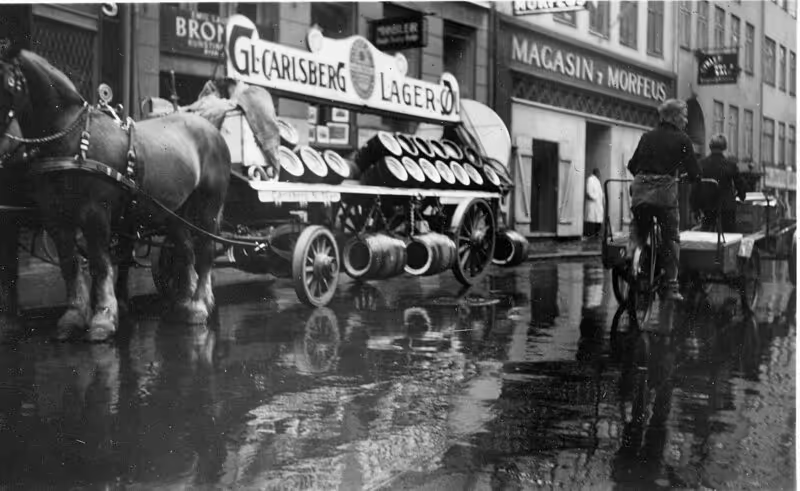
A simple yet meaningful name for him.
This set in motion a decades-long movement to redefine the brewing industry for good.
The Massive Fire With Which It Could All Have Come Crashing Down
In 1867, the Carlsberg brewery, still finding its feet, suffered from a massive fire.
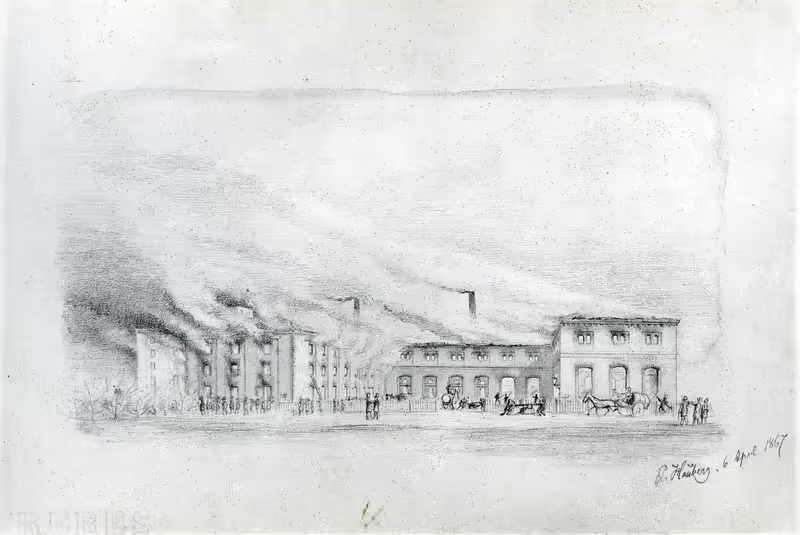
While it could have derailed the company given it was a huge setback, J.C Jacobsen took it as an opportunity to modernize the brewery and ensure it doesn't happen again.
He installed a cooling system that helped keep the temperature in check and enhanced the quality of the product, driving sales and revenue.
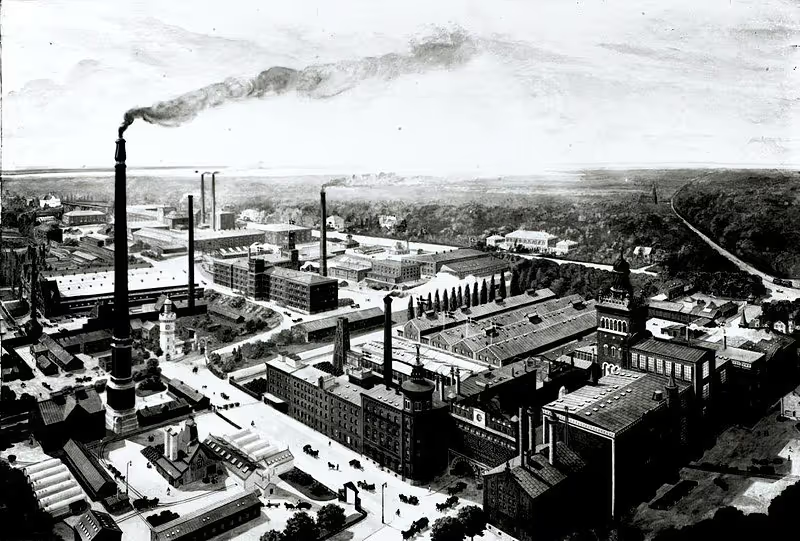
Opening Up To The World
Twenty-one years after being incorporated, Carlsberg also finally got the stamp of international approval in 1868 when it exported Carlsberg beer to Great Britain.
The company has never looked back since and continued to scale its operations and exports to markets worldwide.
The Desire To Continuously Improve Brought About Remarkable Inventions
The 1870s marked the period where Carlsberg focused on the bigger picture and set itself up for success.
In 1875, the Carlsberg Laboratory was founded to study the malting, brewing, and fermenting process in detail. It had a special Department of Chemistry and Department of Physiology that focused on optimizing the beer production process and enhancing its quality while expanding the boundaries in the respective fields.
From developing the key to a perfectly consistent beer production – cultivating pure yeast – to introducing the concept of PH unit in 1909 to measure the acidity or alkalinity of a substance and making advances in protein chemistry, the Carlsberg Laboratory continued its merry way of research and developing throughout the 19th and 20th century.
The cultivation of pure yeast cultures in 1883 by Professor Emil Christian Hansen at the Carlsberg Laboratory was a big breakthrough for the brewery industry. It not only revealed that bad beer was indeed a result of bacterial infection as already pointed out but also the result of contamination by wild yeast.
He concluded that rather than using beer from previous fermentations for brewing, fresh yeast could be used every time to produce beer.
This meant that Carlsberg could now consistently produce high-quality tasty beer without any issues (and so could the other companies).
In 1876, J.C Jacobsen also set up the Carlsberg Foundation to manage the Carlsberg Laboratory and also support scientific research.
The Son & Father Duel
In an unlikely turn of events, Jacobsen's son Carl, who returned from Europe after studying the brewery process and was invited to brew his own beer in the annex brewery given to him by his father, started his own venture in 1982.
He named his brewery – New Carlsberg – forcing his father's brewery to rename his brewery to Old Carlsberg.
Carl changed things around and strived to meet the growing market demand by increasing capacity and cutting down the brewing process to save up on time and resources without compromising on the quality.
Such was the impact that Carl managed to gain market share exponentially and within ten years surpassed the sales of his father's company, the old Carlsberg.
Safe to say, using the same name as his father's company and manufacturing a beer with half the storage time did not sit well with Jacobsen.
It led to a years-long family feud, which was eventually resolved in 1886, before Jacobsen's death the following year.
Key Takeaway 1: Follow Your Passion & Continue To Improve Your Offerings
The Carlsberg group was the by-product of a true renaissance man, J.C Jacobsen, who, in addition to his passion for beers, was a firm believer in quality, research, and serving the community.
From picking himself up after difficult times, such as the fire in 1868 and his son becoming his competition to focusing on long-term growth over short-term gain by setting up a research center and laboratory, Jacobsen was a pioneer in the brewing industry and had an unquenchable thirst for progress.
Such has been his contribution that these values are ingrained in the company and part of its DNA even now.
The Show Goes On & On
J.C Jacobsen passed away during a visit to Rome, and while it was a huge setback given the fact that the leader and founder of the company were no longer there, the show went on.
The Carlsberg Foundation took the ownership and management of Old Carlsberg while Carl continued to head the New Carlsberg.
In 1889, Carlsberg began exporting to Asia, having already previously sent consignments of beer to China and the Far east in 1969 to determine whether or not it was a suitable product for export to these emerging markets. It was a significant landmark given that the company was eyeing expansion in different parts of the world.
Here Comes The Carlsberg Pilsner
The flagship beer of the Carlsberg Group, Carlsberg Pilsner, also referred to as Carlsberg Lager and Carlsberg Beer, was introduced in 1904 by Carl Jacobsen.
Given that both father and son were very particular about the design and looks, it comes as no surprise that everything from the Carlsberg building styles to the labels was paid quite a bit of attention to.
The Danish architect and artist, Thorvald Bindesbøl was hired to design the label of the Carlsberg Pilsner, which later on became the logo of the entire company as well.
He did an amazing job by re-introducing the art Nouveau style and making it popular once again.

In the same year, Carlsberg also became the first Danish brewery to have the prestigious honor of supplying beer to the Royal Danish Court.
The crown in the Carlsberg label symbolizes just that, and the natural ingredients of Carlsberg are highlighted through the hope leaf.
The Much-awaited Merger
It was only fair that the old and new Carlsberg joined forces to achieve economies of scale and benefit from synergies.
That’s exactly what happened in 1906.
Carl became the managing director of Carlsberg breweries, and the company looked forward to a promising future.
The 1900’s Driven By Expansion
With the merger of the old and new Carlsberg, the company was set to grow.
However, things took a turn for the worst as in 1914, Carl died, and the turbulence of the World Wars followed.
Denmark was a neutral state during the wars and occupied by the Germans during World War 2.
Prior to the war, the Danish government was given a price agreement in which the breweries were allowed to operate in a healthy environment in return for consistent tax returns. This served both – the companies and the government – during the war as companies such as Carlsberg continued to thrive, benefiting themselves and the authorities.
In 1932, Carlberg set up an export department to double down on growing externally – outside of Denmark, and regular visits were started to import agents to find mutually beneficial opportunities worldwide.
Once the war was over, Carlsberg was free to pursue its plan of global dominance, and it wasted no time in doing just that.
In 1954, Carlsberg was sending a loaded ship off to Great Britain, its largest export market, every 12 days. At the same time, it contracted a few companies in various countries such as Ireland, Gibraltar, and Malta to bottle its beer for the local markets.
In a bid to expand its operations and truly become a global brewery, Carlsberg had to move its production outside Denmark. Hence, it gave the first overseas production license to Photiades Breweries in Cyprus in 1966, allowing Carlsberg to be brewed for the first time outside of Denmark.
Just after that, in 1968, Carlsberg also built a brewery outside of Denmark – in Blantyre, Malawi.
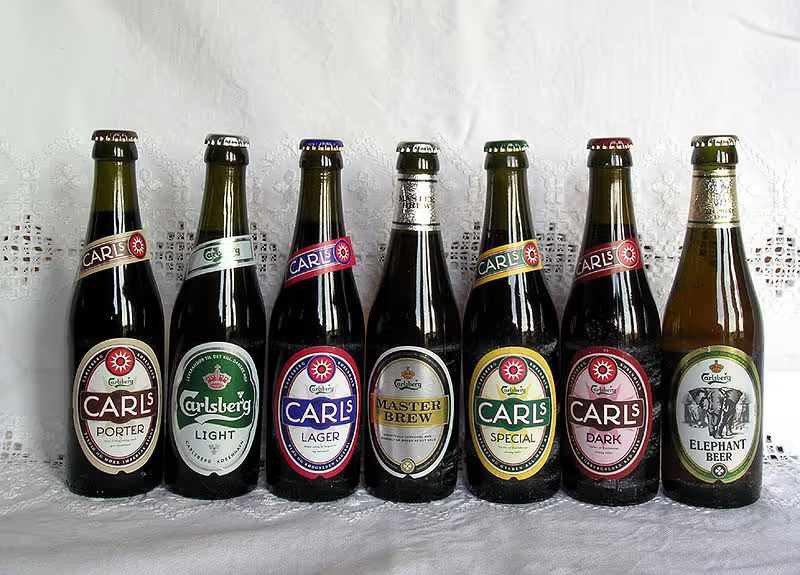
From 1968-1990s, Carlsberg continued to expand internationally by establishing breweries in different regions. After opening the first brewery in Blantyre, Malawi, as part of Denmark’s development assistance for the African country, Carlsberg built its first brewery in Malaysia in 1972, followed by one in Northampton, the UK in 1973, and Hong Kong in 1981.
Key Takeaway 2: Expand – Come What May
Despite the challenges such as the death of Jacobson and Carl, thirty-seven years apart, who were the founders of both old and new Carlsberg, the company continued to grow even as the World War raged on.
The introduction of the flagship Carlsberg Pilsner, tactful merger of the old and new Carlsberg, continuous search for new markets for expansion through exports, and collaborations with bottlers and brewers outside Denmark, helped Carlsberg further its reach and become a global player.
This underlines the significance of looking out for opportunities even when times are difficult and trying your best to diversify the product portfolio and expand to new marketplaces to scale up.
Driving Business Growth Through Mergers
We can’t talk about the mergers of Carlsberg over the years without first talking about the merger of the Ny (New) Carlsberg and Gamle (Old) Carlsberg, can we?
In 1906, The Carlsberg Breweries (Carlsberg Bryggerierne) was formed after the merger of two Carlsberg – one formed by the father and the other by the son.
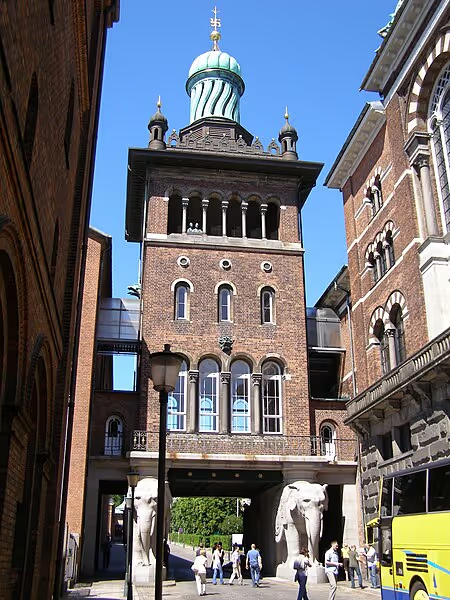
Having finally realized that there was no economic sense to run two distinctive production units and compromise on each other’s business, suffering from losses in the long run when the two could combine forces to enhance efficiency, capture greater market share, and grow the company, the two Carlsberg’s merged.
Carlsberg & Tuborg
The next merger came in 1970, when Carlsberg joined hands with Tuborg breweries, forming the United Breweries AS.
However, it was years ago, in 1903, that both Carlsberg and Tuborg partnered up for the first time. Both these companies were ruling the Danish beer market, but they realized that the market size was relatively small, and they needed to expand.
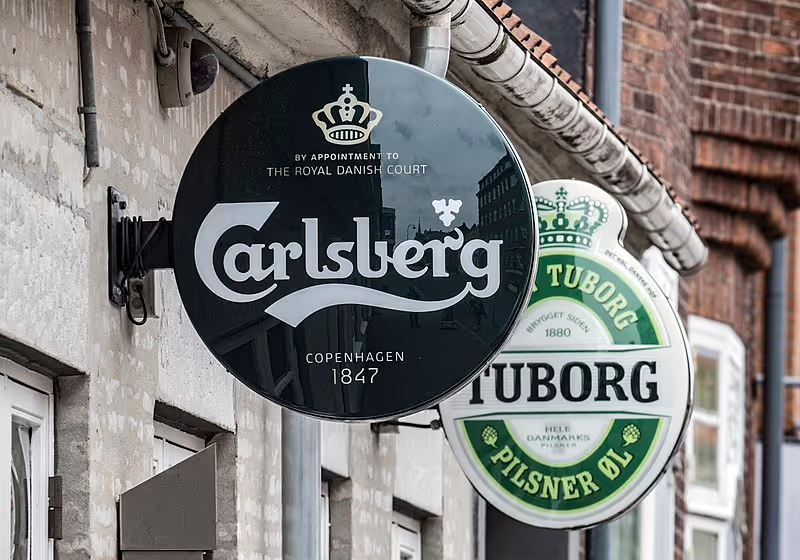
Hence, the two breweries signed an operating agreement at the start of the twentieth century in which they decided to share the profits and losses equally to finance new plants and machinery. Eventually, they also decided to expand in foreign markets.
After World War 2, they began aggressively marketing abroad, more specifically in Asia and Europe, and in the span of 1958 to 1972, their exports almost tripled.
To further reinforce their respective companies and scale their operations overseas, they decided to merge together. As a result, United Breweries was born. The Carlsberg Foundation was awarded 51 percent of the shares of the company.
More Mergers...
Carlsberg merged with Allied Lyons – owners of Tetley’s ale – 1992 and formed Carlsberg-Tetley PLC with a controlling share of 50 percent for each. In the very next year, Allied further sold a 50% stake to Carlsberg, leading to the creation of Carlsberg-Tetley.
In 1996, Carlsberg and Bass were considering merging Carlsberg-Tetley and Bass Breweries. This could have created U.K.'s largest brewing company, but the U.K. government blocked the merger. In the following year, Carlsberg acquired complete ownership of the company, which was named Carlsberg U.K. in 2004. In 2008, during the global financial crisis, Carlsberg announced that the Tetley Brewery in Leeds would be closed down for production in 2011 and later on, it was converted to The Tetley Centre for Contemporary Art and Learning.
Carlsberg & Orkla
In 2001, Carlsberg A/S and Orkla, a Norwegian conglomerate, completed a merger to establish Carlsberg breweries to be owned 60% by Carlsberg A/S and 40% by Orkla.
In 2014, Carlsberg bought out Orkla and extended its collaboration with Scottish & Newcastle. This set up the company to grow both in terms of size and profitability.
By restricting, Carlsberg made it clear that it’s doubling down and enhancing its focus on beer. It was clear to Carlsberg that to grow, it needed to expand into new countries, seize market share, and distribute beer as economically as possible.
The merger with Orkla allows it to do just that. Moreover, it will increase Carlsberg’s presence in Scandinavian countries and Eastern Europe while also allowing it to make a mark in Russia, where beer consumption is on the rise and Orkla has a controlling stake in Baltic Beverages Holdings (BBH). In 2008, Carlsberg became Carlsberg group and acquired 50% of Scottish & Newcastle while gaining control of Russian and Baltic breweries, including Baltika Breweries.
Carlsberg In Russia & China
With European and American markets maturing, Carlsberg realized that it had to move to China and Eastern Europe to continue to grow. BBH allowed Carlsberg to swoop into the Russian beer market that was increasing in size and stature. Not only did it help Carlsberg acquire more market power quickly and benefit from local resources as well as competencies, but it also handed them an established distribution network, which lowered the costs and increased the profits.
Carlsberg officially moved to China in 1978 by establishing a brewery in Hong Kong that became a base for expansion in mainland China. However, Carlsberg had already become one of the first exporters to China when it exported beer to China in the mid 19th century. In 1995, Carlsberg acquired a major shareholding in a brewery in Huizhou, Guangdong, and in 1999 moved the production from Hong Kong to Huizhou.
Given the vast population, drinking culture, and the emergence of China as an economic hub meant that beer consumption was going to be high there. Hence, it came as no surprise that Carlsberg wanted to dominate there – more so than ever after the turn of the century. From setting up a greenfield brewery in Qinghai and Ningxia Autonomous Region in 2005 to launching new flavors such as Carlsberg Light in 2011 and partnering up with the Chinese Super League in 2013, Carlsberg set an example on how customization according to the local market can help win market share and allow a company to expand.
Carlsberg Much More Recently...
In 2015, to consolidate the research and development unit, the Carlsberg Laboratory and the Carlsberg Research Centre were integrated under the name Carlsberg Research Laboratory.
Just two years later, in 2017, Carlsberg snapped up London Fields Brewery and added high-quality craft and beers such as Craft Lager, Easy IPA, and Shoreditch Triangle IPA to its portfolio.
In 2020, Carlsberg formed a joint venture by merging with Marston’s PLC in the U.K., aiming to grow its unrivaled portfolio of premium beer brands and provide its customers with an array of options while enhancing its capacity, product innovation, and marketing and distribution efficiency.
Key Takeaway 3: Mergers & Acquisitions: A Tried & Tested Strategy To Grow
Carlsberg has continued to grow by strategically merging and acquiring companies.
From Tuborg and Allied Lyons to Orkla, London Fields Brewery, and Marston’s PLC, Carlsberg has partnered up with different companies all across the globe.
This enabled Carlsberg to grow without wasting valuable time, resources and having to undergo long learning curves.
It, in turn, helped Carlsberg establish a presence in different regions right from Europe to Asia, benefit from economies of scale, experiment, and scale up the Carlsberg brand to make it a globally renowned and celebrated company.
The X-factor: Carlsberg Marketing
To propel the Carlsberg brand to new heights and make it a household name, Carlsberg began aggressively marketing the company after the mid-20th century.
It used newspapers as the primary medium to reach its target audience initially. After all, newspapers were widely read in the 1950s, ’60s, and ’70s.
In 1973, the famous tagline “Probably the best lager in the world” was created for the U.K. market by Tony Bodinetz at KMP (in some countries, it was changed to “Probably the best beer in the world”). It was a hit and hence, continued in corporate ads around the globe till 2011.
Carlsberg also released ads on television by actor Orson Welles in the 1980s and was even featured in a film – Ice Cold in Alex – as the lager the cast gets to drink after driving across the desert. This led to the creation of one of the best advertising slogans: “worth waiting for.”
In 2011, a new tagline, “That calls for a Carlsberg,” was introduced as the company thought its previous tagline was too subtle, and well, they needed a change to drive sales and be on the forefront of the minds of people.

This new campaign was rolled out in over 140 markets and also included a half-minute T.V. ad called the Spaceman.
In 2019, Carlsberg took the world by storm with its award-winning marketing campaign where it changed its tagline to “Probably not the best beer in the world,” in the U.K., given that the company was lately not doing well there.
It shocked people and created a lot of buzz on social media – just as the company hoped. The company started a conversation, engaged people, and closed the conversations by delivering its message.
Once Carlsberg was successful in attracting attention, it unveiled a national media campaign that announced the new Carlsberg Danish Pilsner, which was re-brewed from head to hop.
A combination of roadside, rail and underground billboards was used coupled with digital marketing to enhance the reach and engagement.
Apart from advertisements, Carlsberg has, over the years, invested heavily in sponsorships either directly from the Carlsberg brewery or as contributions from the Carlsberg Foundation.
From sponsoring events such as the 1990 FIFA World Cup to Euro 2008, 2012, and 2016 as well as teams in the English Premier League, namely Liverpool F.C and Arsenal F.C., Carlsberg cleverly marketed itself to people worldwide and soccer fans who are considered to be the primary consumers of Carlsberg.
Carlsberg was the sponsor of the Indian Premier League franchise Kings XI Punjab, knowing that cricket was the main sport that people were extremely passionate about.
Key Takeaway 4: Be Creative With Marketing
From the various taglines to combining the classical and modern ways of marketing, Carlsberg has done it all in its bid to carve a positive image in the mind of its customers and ensure they remember it.
By not being afraid to be bold and take risks, Carlsberg has churned out quite a few successful advertising campaigns, such as the 1973 iconic tagline one and the 2019 one, which shocked the people.
It underlines the importance of marketing innovatively and thinking out of the box to hook people and deliver the underlying message with a twist. After all, people love to be enticed and wooed.
Carlsberg's SAIL'22 Strategy To Dominate
Carlsberg has a specific strategy that defines its business agenda and enables it to continuously do what it does best: delight people around the globe with high-quality beverages.
Let's now take a look at Carlsberg's strategy in detail:
Strengthen The Core
It includes focusing internally on the business and leveraging the strongholds such as the local brands, which should be strengthened, and global brands that should drive the company forward.
Another critical aspect here is excelling at execution to secure a fair share in the beer category, increase the share of beer in adjacent categories, and expand the portfolio. Moreover, harnessing the power of digital, segmenting customers to better cater to their needs, and innovating to remain a step ahead of the competition all lie in the umbrella of strengthening the core.
Finally, funding the journey culture, which entails ensuring supply chain efficiency, operating cost efficiency, commercial spend efficiency, and reporting as well as tracking, is also an integral part of solidifying the heart and soul of the company.
Position For Growth
One thing that Carlsberg doesn't do is stand idle. It continuously positions itself to grow.
It looks at different opportunities and picks the ones that can yield the most benefits to the company stakeholders.
Currently, winning in craft and specialty and alcohol-free brews as well as expanding in Asia is the primary focus as the company firmly believes these can give it an edge and help it scale.
Create A Winning Culture
Carlsberg understands that its people and culture are of utmost importance.
Hence, the company leaves no stone unturned in creating a team-based and performance-driven culture.
There are short-term and long-term incentives schemes that align with value creation, commitment to responsibly doing business, ensuring diversity and inclusion, and sustainability by going towards zero carbon footprint, zero water waste, zero irresponsible drinking, and zero accidents culture.

Deliver Sustainable Value To Shareholders
Last but not least, Carlsberg puts great emphasis on delivering results and providing value to shareholders through organic growth in operating profit, ROIC, and optimal allocation of capital.
Key Takeaway 5: An Effective Business Strategy Is Essential
Carlsberg firmly stands by its SAIL'22 strategy, which includes strengthening the core, positioning for growth, creating a winning culture, and delivering value to shareholders.
Carlsberg understands the importance of a business strategy serving as a blueprint for the different aspects of running a business, right from allowing a business to introspect how it's doing internally and externally and what concrete steps it will take to achieve the desired results.
Carlsberg Today & Strategic Takeaways
Carlsberg has redefined and changed brewing forever. In the process, it has become one of the leading companies in the beverages industry.
However, the recent disruption brought to the fore by the Covid-19 has hit Carlsberg hard, with its sales plunging to the lowest levels since the global financial crisis in 2007-08.
Even amid heightened uncertainty, market volatility, and a plethora of challenges ranging from supply-chain issues to compromised business operations, Carlsberg remained steadfast and delivered solid results.
This was down to the:
- The geographical footprint of the company in Asia as well as Western and Eastern Europe
- Brand portfolio resilience thanks to strong local and global brands, price point and pack formats to adapt to evolving customer demands, and growth of craft and specialty and alcohol-free beers
- Organizational and people resilience as evident from successful execution of initiative such as new flexible ways of working and no serious business discontinuity
- Financial resilience as despite Covid-19, Carlberg enhanced the operating margin, delivering strong cash-flow, grew the business through acquisitions, carried out a share buyback program, and increased dividend per share
Growth By Numbers
Explore Areas That Spark Your Interest & Success Will Follow
Carlsberg is the brainchild of a man who followed what he was most passionate about – beers – and worked extremely hard to offer something new and exciting to the world.
From studying brewing in Germany to experimenting at his home, J.C Jacobsen did it all in his quest to produce the best lager in the world.
Note that he wasn’t motivated by money or wanted to start a business just for the sake of it. He genuinely wanted to make the perfect beer.
This is precisely why he set up the Carlsberg laboratory to research more on brewing as well as improve the quality of the end-product and why he kept going despite the hurdles he faced, such as the devastating fire in 1867 and duel with his son.
His passion for beer helped the company achieve success, and it is still one of the fundamental driving the business even today as it hopes to brew better today and tomorrow.
Never Settle: Keep Looking For Opportunities
Carlsberg could have thrown in the towel. With J.C Jacobsen and Carl, the founders of old and new Carlsberg dead and the World Wars raging, it was easy to simply go with the motion.
However, Carlsberg did not do that. It introduced a new successful product - Carlsberg Pilsner – expanded to new markets, collaborated with bottlers and brewers outside Denmark to scale up and establish a global presence.
By building on the current business, Carlsberg set itself up to become a dominant force.
Today, the rapid pace of change is such that a couple of missed opportunities can drive you out of business.
Hence, it becomes all the more important to remain on your toes and be on the lookout for opportunities that you can embrace to grow your business.
Leverage Mergers & Acquisitions To Grow Quickly
Strategic mergers and acquisitions can help any company achieve a competitive advantage and drive business growth.
It’s not easy to re-invent the wheel. Carlsberg knew that right from the beginning.
This is precisely why it leveraged mergers and acquisitions throughout the 20th and 21st centuries.
Right from Tuborg and Allied Lyons to Orkla, London Fields Brewery, and Marston’s PLC, Carlsberg partnered up with a number of companies in different parts of the world to establish a presence in different regions of the world, diversify its brand portfolio, cater to foreign markets, and grow quickly as well as efficiently.
Tactful Marketing Can Elevate Your Brand
How do you establish a brand identity and create brand affinity? How do you drive sales and revenue?
By marketing.
Simply put, you can have the best product or service, but if you do not market your brand effectively, you simply won’t succeed.
From the iconic Carlsberg tag line “Probably the best beer in the world” to “That calls for a Carlsberg” and proactive marketing campaigns ranging from sponsoring sporting events such as the FIFA world cup and Euro Cup to name a few, Carlsberg has always focused on being at the forefront of its target audience’s mind by marketing creatively.
It has indeed helped the company by enhancing brand awareness and visibility.
Do Right By The People & The Planet
No, Carlsberg isn’t just another company trying its best to make huge profits while negatively impacting the people and the planet.
In fact, Carlsberg has one of the most ambitious sustainability programs and is striving to achieve zero carbon footprint, zero water waste, zero irresponsible drinking, and zero accidents culture.
The company is mindful of its actions and aims to mitigate risks, tackle global challenges such as climate change and water scarcity, and do business in an ethical way by responsible sourcing and upholding human and labor rights.
This highlights the need for businesses to set an example for others to follow and act responsibly for the greater good.



